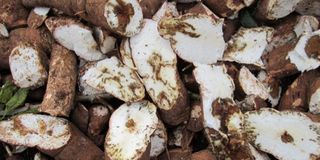Device to fight cassava diseases launched

What you need to know:
Nuru, as the device is known, has been developed by the International Institute of Tropical Agriculture (IITA) in collaboration with the Pennsylvania State University of the United States.
Arusha. A new tool to fight cassava diseases using an artificially intelligent machine has been launched.
Nuru, as the device is known, has been developed by the International Institute of Tropical Agriculture (IITA) in collaboration with the Pennsylvania State University of the United States.
The machine, according to the institute’s official, can accurately recognise leaves damaged by the two viral diseases attacking the crop as well as damage by red and green mites.
The two diseases, Cassava Mosaic and Cassava Brown Streak, are said to be have affected hugely cassava production in Africa, reducing the yield by 50 per cent.
“It is hard for farmers to get information about their cassava and particularly to get identifications for viral diseases. Nuru can help to overcome both challenges,” said Catherine Njuguna, a communication officer with IITA.
Through it, information about the diseases and capability to diagnose them can be accessed by any farmer or extension officer with a smartphone, she added when reached by The Citizen.
The tool, noted James Legg, a virologist on the cassava disease control programme, uses a convolutional neural network to analyse visual imagery and runs inside a standard Adroid phone offline.
The application built at Pennsylvania State with the support of CGIAR, a global agricultural research body, can also diagnose the damage of the devastating invasive fall armyworm (FAW).
The multilingual Nuru will also help farmers to scout their fields to see how many plants are affected “and automatically calculate the incidence of cassava diseases in the fields visited”.
IITA officials say data collected will be aggregated from across the African continent into a database to better understand the epidemiology of cassava virus diseases.
“This will greatly help decision makers to allocate resources more effectively”, he explained, noting that once the farmers check their crops for infections and upload the required data, the device will give advice on how to manage the situation.
While cassava, one of the major staple food in the developing countries, is perennially subjected to viral diseases, the crop is also attacked by pests.
In Tanzania, the second largest cassava producer in East Africa, diseases are reported to have reduced cassava yields by over 50 per cent from 10.5 tonnes per hectare to only 5.5 tonnes per ha.



